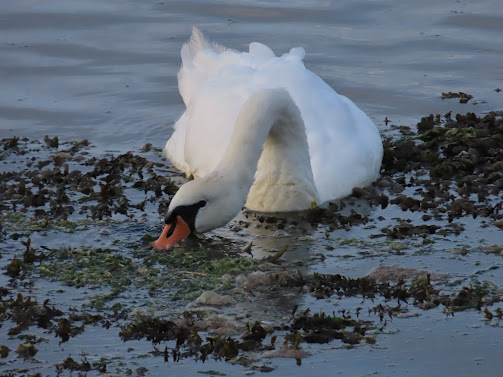Being a border region for so long, Northumbria shares many characteristics of its erstwhile conquerors. In the landscape you can see the ruggedness and haunting beauty of Scotland, seen in its many cliffs and islands. And yet it has that civility which reminds me of England, a tameness that offsets its more rougher edges. The Northumbrian Coast is a beautiful stretch of countryside, designated an Area of Outstanding Natural Beauty, like the Suffolk and North Norfolk Coasts, and is a place I was lucky enough to spend a week in in mid July. The summer season is all about the sea bird cities that populate the many cliffs and offshore islands that sprout up in this area of the country. With mid July being the end of the season, numbers weren't as impressive as they would be in June, but they were still worth a look to catch some late nesters.
I stayed in a cottage south of the river Tweed, facing directly into Berwick, on the outskirts of a town called Spittal. The views were absolutely amazing from there, facing the walls of the town looking down onto the tidal river. The tide came in and out as its done since time immemorial and the birds waxed and waned to the conditions the river created. Berwick is a great little city with many amenities, places of historic interest and nice restaurants so is worth a look in its own right.
The main bird feature of Berwick and the Tweed is the large flock of MUTE SWANS which is stationed there. Several hundred birds spend their time here, a big gathering of birds, congregating together to beat the loneliness that besets the none breeders. They don't nest here, swans are common nesters on the river further down, but gather together because they don't have anything else to do. They like to feed on the tidal edge, on the water weeds that grow there and the birds form a long line across the water's edge. The birds would hang out in large herds, enjoying the best feeding places, but will often split up, the birds forming a polite line, a mile long to move onto someplace new.
In my stay here the strangest sighting from the area, and it was pretty strange, was that of a QUAIL, on Spittal beach. As I was walking through the marram grass in the beach dunes, this tiny little bird flew out, stubby wings flapping on overdrive, a bird similar in shape, but half the size, of a partridge. A quail. What it was doing here I don't know, but I'm guessing it was a migrant, as it was too busy an area to nest. Quails are so hard to see, being so small and lovers of thick cover, that this constitutes my first sighting of this tiny little bird. And because it was so strange in its timing, one of the best.
Being an estuarine river, the Tweed retreated at low tide to reveal lots of mud, which attracted plenty of WADERS. CURLEWS were plentiful, with a flock peaking at thirty five, as well as a WHIMBREL joining them on the16/7. There were plenty of REDSHANK, OYSTERCATCHERS as you would expect, but nothing out of the ordinary.
At this time of year DUCKS are going into eclipse, where the male birds shed their plumage feathers, to regrow them over the late summer. As a result the males appear brown and dowdy, like the females, and are flightless, so gather on large bodies of water for safety. RED BREASTED MERGANSERS dominated with as many as seventy on the river, sometimes in one super flock, other times often in small numbers. A few EIDERS were about both male and female a dull brown, Northumbria, with its rocky coastline is a stronghold of this species.
Even though birds tend to dominate the wildlife, I am a birdwacther after all, the MAMMALS seen on the Tweed must get a worthy mention. From the cottage, on 17/7 I saw that one of the tourist boats was spending a long time standing still out on the sea, just passed the mouth of the river. Now this got me suspicious, why was that boat just hanging out there, and got the 'scope out to take a quick look. And lo and behold a pod of DOLPHINS were swimming around the boat, their long lithe bodies lifting out of the water to reveal their dorsal fin. For ten minutes the dolphins swam around the boat, the people aboard were so lucky. It was just magical. On 16/7 I had an OTTER briefly and far away, however I could make out its distinctive shape seen swimming in the river. And of course there were GREY SEALS. The Farne Islands has the largest colony in the world, and they're just everywhere along the coast here. They're always such curious animals, watching you watching them, head sticking up from the water, observing you with this animal intelligence you can see deepset in their eyes.
Even on the outskirts of a busy town nature thrives. The Tweed is such a large habitat, one that moves through an ever changing landscape, and then itself changes completely, becoming brackish before disappearing completely as it enters the sea. And to be able to just look over this river, to just experience the heart beat of life on it, was to feel truly blessed. And it was a superb way to spend a week, and I thoroughly recommend this area of the country to anyone with an interest in nature.










No comments:
Post a Comment